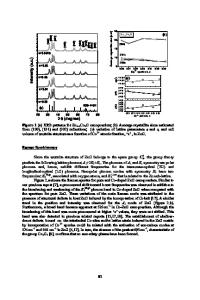Structural, Optical, and Magnetic Behavior of in-situ Doped, MOCVD-Grown Ga 1-x Mn x N Epilayers and Heterostructures
- PDF / 213,415 Bytes
- 6 Pages / 612 x 792 pts (letter) Page_size
- 57 Downloads / 365 Views
0892-FF07-04-EE05-04.1
Structural, Optical, and Magnetic Behavior of in-situ doped, MOCVD - Grown Ga1-xMnxN Epilayers and Heterostructures. M. H. Kane1,2, W.E. Fenwick2, M. Strassburg2,3, A. Asghar2, S. Gupta2, H. Kang 2, N. Li2 ,C. J. Summers1, and I. T. Ferguson1,2 1
Georgia Institute of Technology, School of Materials Science and Engineering, Atlanta, GA 30332-245, U.S.A. 2 Georgia Institute of Technology, School of Electrical and Computer Engineering, Atlanta, GA 30332-0250, U.S.A. 3 Georgia State University, Department of Physics and Astronomy, Atlanta, GA 30303, U.S.A. ABSTRACT Dilute magnetic semiconductors (DMS) show promise as materials that can exhibit ferromagnetism at room temperature (RT). However, the nature of ferromagnetism in this material system must be well understood in order to allow intelligent design of RT spintronic devices. This work investigates the magnetic properties of the as-grown films and the effect of Mn incorporation on crystal integrity and device performance. Ga1-xMnxN films were grown by MOCVD on c-plane sapphire substrates with varying thickness and Mn concentration. Homogenous Mn incorporation throughout the films was verified with Secondary Ion Mass Spectroscopy (SIMS), and no macroscopic second phases (MnxNy) were detected using X-ray diffraction (XRD). Superior crystalline quality in the MOCVD-grown films relative to Mnimplanted GaN epilayers was confirmed via Raman spectroscopy. Vibrating sample magnetometry (VSM) measurements showed an apparent room temperature ferromagnetic hysteresis in the as-grown epiayers. Similarly, a marked decrease in the magnetization was observed with annealing and silicon doping, as well as in post-growth annealed Mg-codoped samples. The observed decrease in µB per Mn with increasing Mn concentration is explained by Raman spectroscopy results, which show a decrease in long-range lattice ordering and an increase in nitrogen vacancy concentration with increasing Mn concentration. Light emitting diodes (LEDs) containing a Mn-doped active region have also been produced. Devices were fabricated with different Mn-doped active layer thicknesses, and I-V characteristics show that the devices become more resistive as thickness of the Mn-doped active layer increases. The electroluminescence of the Mn-containing layers is red-orange vice blue. Under ultraviolet illumination, there is an increase in the measured VSM signal from Mn-containing layers. INTRODUCTION Research on nitride-based ferromagnetic semiconductors has been an area of intense focus since the prediction of room temperature ferromagnetism in these materials [1], driven by the promise of their use in spintronic application [2]. Existing diluted magnetic semiconductors (DMS) such as Ga1-xMnxAs have demonstrated some promise in device application such as Spin LEDs, but have only been able to reach Curie temperatures of 170 K [3]. Theoretical predictions have suggested that this may be able to be pushed above room temperature in wide bandgap materials [1], provided that the materials can be do
Data Loading...











